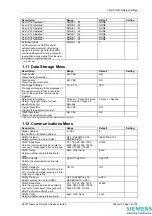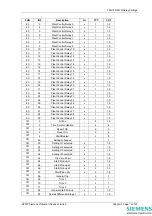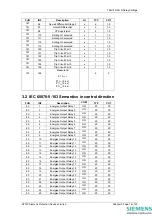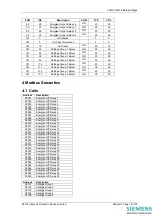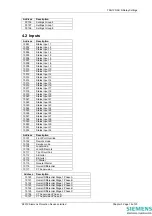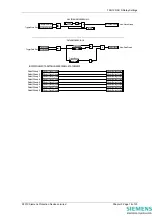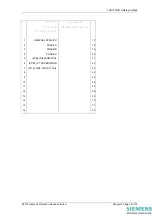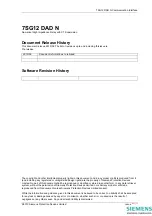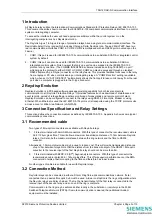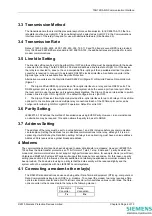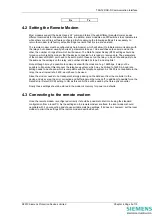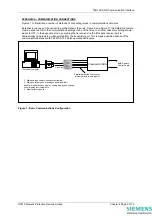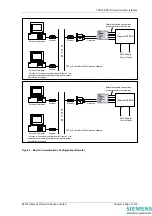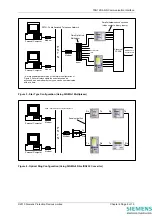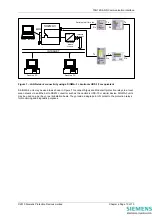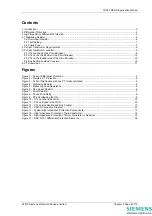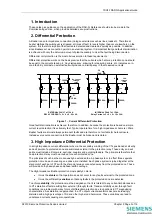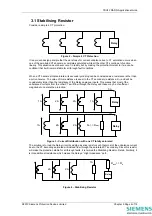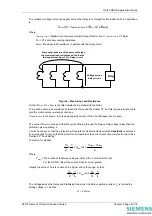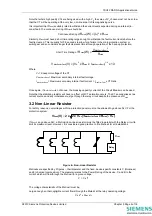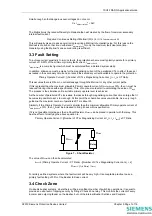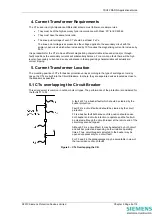
7SG12 DAD-N Communication Interface
3.3 Transmission Method
The transmission method is Half Duplex serial asynchronous transmission. In IEC 60870-5-103 the line
idle state is defined as Light ON. This can alternatively be selected as Light OFF in the Communications
Interface menu of the relay if required for use with alternate hardware (See Section 2.5).
3.4 Transmission Rate
Rates of 19200, 9600, 4800, 2400, 1200, 600, 300, 150, 110 and 75 bits per second (BPS) are provided.
Only 19200 and 9600 BPS are standard in IEC 60870-5-103, the additional rates are provided for local or
modem communications.
3.5 Line Idle Setting
The line idle setting can be set to be either ON or OFF and the setting must be compatible with the device
connected to the relay. The IEC 60870-5-103 standard defines a line idle state of Light
On. If the device
the relay is connected to, does not have a compatible fibre-optic port then a suitable electrical to optical
converter is required to connect it to a standard RS232C electrical interface. A suitable converter is the
Sigma 4 type, which is available from Reyrolle Protection.
Alternative converters are the Reyrolle Dual RS232 Port (Sigma 3) or Reyrolle Passive Fibre-Optic Hub
(Sigma 1).
1.
The Sigma 3 Dual RS232 port provides a fibre-optic interface to a relay and two RS232 ports. The
RS232 system port is typically connected to a control system while the second port is a local port. When
the local port is in use the system port is automatically disabled. The Sigma 3 has an internal link to switch
between line idle Light ON or Light OFF. The default configuration is Light OFF.
2.
The Sigma 1 Passive Fibre-Optic Hub provides fibre-optic interfaces for up to 29 relays. It has a fibre-
optic port to the control system and multiple relay connections. Each of the 30 fibre-optic ports can be
configured for either Light ON or Light OFF operation. Default for all is OFF.
3.6 Parity Setting
IEC60870-5-103 defines the method of transmission as using EVEN Parity. However, in some instances
an alternative may be required. This option allows the parity to be set to NONE.
3.7 Address Setting
The address of the relay must be set to a value between 1 and 254 inclusive before any communication
can take place. Setting the address to zero disables communications to the relay, although if it is in an
optical ring it will still obey the Data Echo setting. All relays in an optical ring must have a unique address.
Address 255 is reserved as a global broadcast address.
4 Modems
The communications interface has been designed to allow data transfer via modems. However, IEC60870-5-
103 defines the data transfer protocol as an 11 bit format of 1 start, 1 stop, 8 data and 1 parity bit which is a
mode most commercial modems do not support. High performance modems, for example, Sonix (now 3Com),
Volante and MultiTech Systems MT series will support this mode but are expensive. For this reason a parity
setting (see section 2.6) to allow use of easily available and relatively inexpensive commercial modems has
been provided. The downside to using no parity is that the data security will be reduced slightly and the
system will not be compatible with true IEC60870 control systems.
4.1 Connecting a modem to the relay(s)
The RS232C standard defines devices as being either Data Terminal Equipment (DTE) e.g. computers, or
Data Communications Equipment (DCE) e.g. modems. To connect the modem to a relay requires a fibre-
optic to electrical connector and a Null Terminal connector which switches various control lines. The fibre-
optic converter is then connected to the relay in the following manner :
Fibre-Optic
Converter
Relay
Connection
Tx Rx
©2010 Siemens Protection Devices Limited
Chapter 4 Page 4 of 10
Содержание 7SG12 DAD-N
Страница 2: ......

